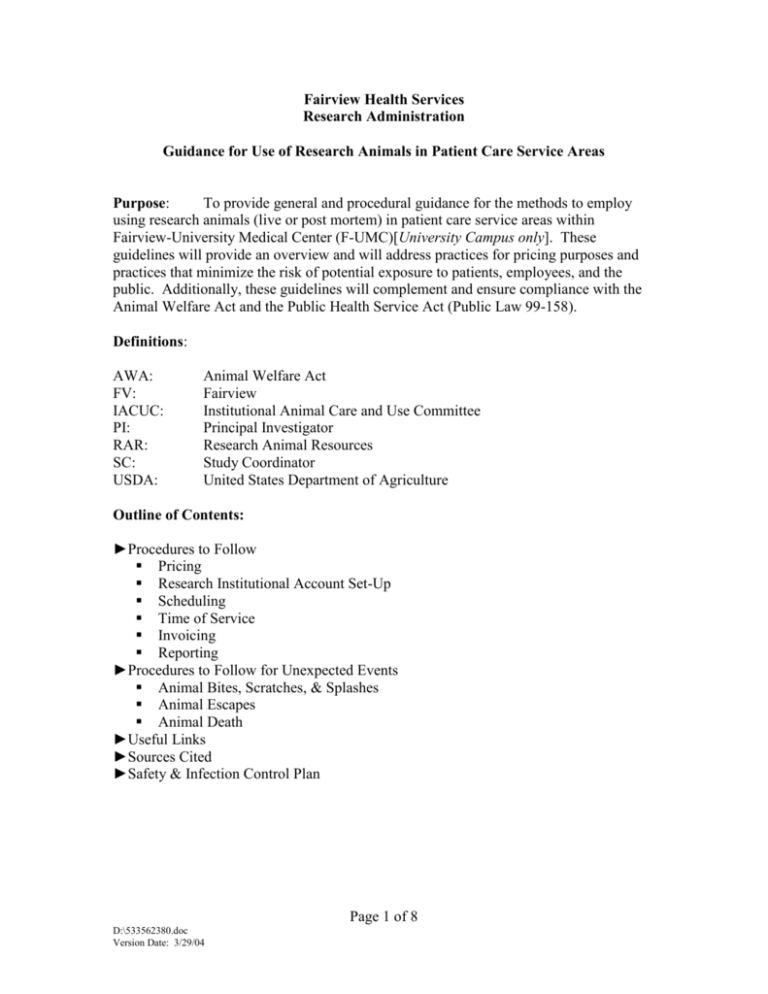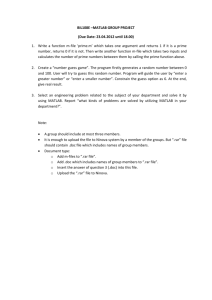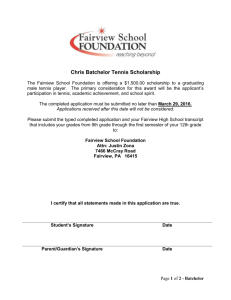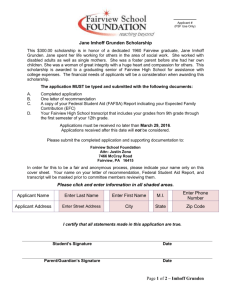Animals in Fairview Patient Areas
advertisement

Fairview Health Services Research Administration Guidance for Use of Research Animals in Patient Care Service Areas Purpose: To provide general and procedural guidance for the methods to employ using research animals (live or post mortem) in patient care service areas within Fairview-University Medical Center (F-UMC)[University Campus only]. These guidelines will provide an overview and will address practices for pricing purposes and practices that minimize the risk of potential exposure to patients, employees, and the public. Additionally, these guidelines will complement and ensure compliance with the Animal Welfare Act and the Public Health Service Act (Public Law 99-158). Definitions: AWA: FV: IACUC: PI: RAR: SC: USDA: Animal Welfare Act Fairview Institutional Animal Care and Use Committee Principal Investigator Research Animal Resources Study Coordinator United States Department of Agriculture Outline of Contents: ►Procedures to Follow Pricing Research Institutional Account Set-Up Scheduling Time of Service Invoicing Reporting ►Procedures to Follow for Unexpected Events Animal Bites, Scratches, & Splashes Animal Escapes Animal Death ►Useful Links ►Sources Cited ►Safety & Infection Control Plan Page 1 of 8 D:\533562380.doc Version Date: 3/29/04 Procedures to Follow for Researchers Pricing CONTACT the Patient Care Service Area manager to clearly identify the services that will be used. CONTACT FV Research Administration (612-672-7690) for assistance with the pricing of requested services or with the sub-contacting process (if needed). Research Institutional Account Setup ♫ NOTE: A Research Institutional Account (RIA) needs to be established in order to correctly bill for services (unless a subcontract is being used) COMPLETE a Research Institutional Account Request Form (RIARF) after a CUFS number has been generated for the project. The online form is available at: http:www.fairview.org/prof/research/pdf/forms INDICATE that the project is an animal study on the RIARF to ensure that it is communicated to the research billing personnel. AWAIT the receipt of the RIA number (via fax) and the customized study encounter form (via email) Scheduling ♫ NOTE: In accordance with the F-UMC Infection Control Department recommendations, the procedure can only occur when patients are not present in the Patient Care Service Area. SCHEDULE the procedure with the Manager of the Patient Care Service Area REVIEW the plan & obtain approval from the Manager of the Patient Care Service Area PROVIDE the contact information for the responsible research personnel ALERT the Patient Care Service Area Manager if the research animal will be sedated and/or sacrificed in the patient care area before, during or after the procedure. Time of Service ♫ NOTE: The Researcher and Research staff is responsible for developing and adhering to the Safety and Control measures set forth in the shaded area of this section at the time of service when the research animal is located in the Patient Care Service Area. COMPLETE the customized study encounter form and PROVIDE it to the Patient Care Service Area personnel. BRING BITE KITS if non-human primates (i.e. Macaques) are the research animals undergoing the procedure. Page 2 of 8 D:\533562380.doc Version Date: 3/29/04 DISINFECTION of the testing equipment in the Patient Care Service Area is the responsibility of the Researcher and/or Research Staff FOR FAIRVIEW PERSONNEL ONLY Charge Capture Radiology Area charges are entered directly into IDX rad All other service areas can: Directly key the charges into PASS Fax the study encounter form to the CBO (612-672-2833) and the charges will be billed directly to the Research Account (RIA) number Invoicing ♫ NOTE: Invoices are created in the Fairview CBO and are mailed directly to the designated study staff on a monthly basis Reporting ♫ NOTE: The Researcher and Research staff is responsible for reporting the following events as they occur when the research animal is located in the Patient Care Service Area: Animal Bites, Scratches or Splashes (Must report if event happens to either the Research Staff and/or F-UMC staff) Animal Escape Animal Death (See Reporting Procedures for each category below) Procedures for Unexpected Events ►Bites, Scratches, and Splashes from Animals ANIMAL EXPOSURE (Non-primates) MASSAGE the wound immediately CLEANSE and IRRIGATE the wound with soap and running water for at least 15 minutes. Use whatever supplies (disinfectants and bandages) necessary from the First Aid Kit located in the area Page 3 of 8 D:\533562380.doc Version Date: 3/29/04 If the Research Staff is affected, CALL Boynton Health Service (612-625-7900) during daytime hours or after hours GO to Fairview-University Medical Center (F-UMC) Emergency Room (612-273-2700) If the F-UMC staff is affected, GO to Fairview University Medical Center (FUMC) Emergency Room (612-273-2700) NOTIFY your supervisor and take whatever measures are necessary to identify and isolate the animal for evaluation and observation NOTIFY the RAR Veterinarian (612-624-9100) for animal bites or scratches RINSE the affected area with water for at least 15 minutes if feces, urine, saliva or blood splashes into your eyes, mouth, and nose or into a cut in your skin. REPORT the incident to your supervisor and to the Patient Care Service Area Departmental Manager who will route the report to: Director of Infection Control Fairview Safety Officer Director of Research Administration ANIMAL EXPOSURE (Non-human primates, including Macaques (i.e. Rhesus or Cynomolgus) REMAIN CALM FOLLOW the procedures in the Bite Kits if you have a: Bite or scratch that causes bleeding Cage scratch that causes bleeding Puncture with a needle (or an object) that has previously been in a nonhuman primate Splashing of feces, urine, saliva or blood into your eyes, mouth, nose or into a cut in your skin INSTRUCTIONS FOR BITE KIT OPEN the sealed packet containing the scrub brush & soap SCRUB the affected area with the bristle side of the brush SWAB the affected area deeply using the viral culture swabs, replace it in the plastic tube, and squeeze the bottom to break the bulb IF IN EYES, NOSE OR MOUTH RINSE your eyes or the affected area with water for at least 15 minutes. DO NOT SWAB YOUR EYES If the Research staff is bitten, CALL Boynton Health Service (612-625-7900) during business hours or if after hours GO to Fairview-University Medical Center (F-UMC) Emergency Room (612-273-2700). Page 4 of 8 D:\533562380.doc Version Date: 3/29/04 If the F-UMC staff is bitten, GO to Fairview University Medical Center (F-UMC) Emergency Room (612-273-2700) BRING the swab and the sheet called, Boynton Health Non-Human Primate Bite Management of Non-Human Primate Bites, Scratches or Splashes Onto Mucous Membranes (Macaque Species) for either the Research staff or the F-UMC staff member CALL RAR (612-624-9100) and/or PAGE the on-call RAR veterinarian (612899-6285) as soon as possible REPORT the incident to your supervisor and to the Patient Care Service Area Departmental Manager who will route the report to: Director of Infection Control Fairview Safety Officer Director of Research Administration ► Animal Escapes If the research animal escapes while it is located in the Patient Care Service Area: SECURE the area by closing the door of the room or area RECAPTURE the research animal if doing so would not endanger the health of the person attempting to do so. If the researcher is unable to recapture the animal: CALL RAR (612-624-9100) during daytime hours or PAGE the on-call RAR veterinarian (612-899-6285) CALL FV Security (612-273-4544) for further assistance in securing the area (s). REPORT the incident to your supervisor and to the Patient Care Service Area Departmental Manager who will route the report to: Director of Infection Control Fairview Safety Office Director of Research Administration ► Animal Death in Patient Care Service Area In the event of an UNEXPECTED research animal death: CALL RAR (612-624-9100) during daytime hours or PAGE the on-call RAR veterinarian (612-899-6285) for guidance on the removal and the sanitation of the area ♫ DO NOT DISPOSE the research animal carcass in the Patient Care Service Area Biohazard waste receptacles. REPORT the incident to your supervisor and to the Patient Care Service Area Departmental Manager who will route the report to: Director of Infection Control Fairview Safety Officer Page 5 of 8 D:\533562380.doc Version Date: 3/29/04 Director of Research Administration In the event of an EXPECTED research animal death: NOTIFY the Patient Care Service Area Departmental Manager when scheduling the procedure so as to prospectively communicate the plan to the appropriate Fairview staff FOLLOW RAR guidelines for the handling and disposal of the research animal Useful Links IACUC: www.iacuc.umn.edu RAR: www.ahc.umn.edu.rar FV Research: www.fairview.org Sources Cited and Referenced 1. University of Minnesota, Animal Care Program Emergency Plan 2. Fairview Health Services Pricing Policy 3. Fairview Health Services Infection Control Plan Page 6 of 8 D:\533562380.doc Version Date: 3/29/04 Safety & Infection Control Plan ♫ NOTE: The Researcher and Research Staff must be able to communicate, implement and adhere to the strategies developed to address the information contained in sections A-F (see below). Please note that most of the information requested has already been proposed and addressed via the completion of the IACUC application and review process. Therefore, additional information needed for Fairview appears in bold text. ►Transportation The Researcher and Research staff must define and follow the process for which research animals will be transported and must address: Locations from and to which animals will be transported Route via which animals will be transported Personnel who will transport the animals Equipment used to transport the animals Time (s) when the animal will be transported Name & location of research contact person(s) ►Containment The Researcher and Research Staff must describe the containment plan to be in effect when the research animal is located within the Patient Care Service Area to include: Description of the caging (size, material, ventilation, etc) Identification of the caging as permanent or for transportation-purposes only. For both, include the maintenance and sanitation records If applicable, the procedure used when transporting the animal from the caging to the service area equipment before, during, and after the research procedure Description of caging and /or restraint (chemical or physical) to be used when the animal is undergoing the research procedure (refer to the RAR website for Restraint and Handling of Animal Principles) Description of the Action Plan in the event that the animal escapes the restraint and/or caging ►Monitoring & Animal Husbandry The Researcher and Research Staff must identify and adhere to the animal monitoring plan to include: List of personnel responsible for transporting and monitoring the animals during the research procedure Page 7 of 8 D:\533562380.doc Version Date: 3/29/04 Name & location of contact person(s). Contact person must be available before, during, and after the research procedure ► Sedation The Researcher and Research Staff must outline and inform the Patient Care Service Area Departmental Manager at the time of scheduling to be in accordance with the recommendations for the necessity and the use of anesthesia described in the RAR website (refer to the “Guidelines for the Use of Anesthetics, Analgesics, and Tranquilizers in Laboratory Animals”) ► Prevention of Zoonotic Diseases The Researcher and Research Staff must promote the prevention of Zoonotic diseases (those that can be transmitted from animals to humans and from humans to animals). Prevention can be accomplished via the use of personal protective equipment and proper animal handling and restraint. See the RAR website for more details. ► Sanitation Process ♫ NOTE: The Researcher must review the sanitation plan with the Patient Care Service Area Departmental Manager before the time of service. The Researcher and Research Staff must identify a sanitation plan to include: Procedure for cleaning and disinfection of contaminated equipment, surfaces, and floors during or following the research procedure, including the type of hospital grade EPA-approved disinfectant (i.e. Virex) to be used. Identification of personnel responsible for the sanitation process Description of the handling, processing and/or disposal of the soiled cleaning supplies (i.e. separate dedicated biohazard waste bag). Disposal of an animal carcass (if applicable) must be in a separate dedicated biohazard waste bag that will be removed by the research staff and must be in accordance with the RAR guidelines (see website for more details) Page 8 of 8 D:\533562380.doc Version Date: 3/29/04





